J-2X Progress: Engine Assembly Continues
Once upon a time, I used to consider myself reasonably handy with a saw and a drill and a miter box and various rudimentary woodworking tools. I certainly knew my limits, so I never did anything too complex, but most of the fun from pursuing such projects was the creativity involved. I didn’t plan out a great deal. I preferred an evolving, organic (i.e., lazy) approach. Given the nature of the forgiving materials involved, that was generally fine. In my wife’s art studio, there’s a cat tree with six or seven beds that fills an entire wall. I built it with no drawings, kind of on the fly, and it still turned out okay (or, at least, the cats seem to think so).
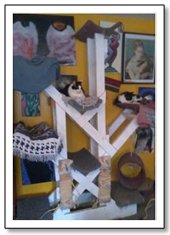
That is not, however, how you assemble a rocket engine. You don’t wing it. You plan everything. The materials are not forgiving. Just about everything is heavy and, if you drop it, or scratch it, or scuff it, or nick it, then you have the joyful experience of traipsing through a paperwork exercise to make sure that whatever you damaged is still usable. In other words, rocket engine pieces are both extremely rugged and rigid yet also precisely machined and fragile. Oh, and unlike two-by-fours, rocket engine parts aren’t cheap and as easily replaced as a trip down the street to Home Depot. Thus, a great deal of time spent poring through the planning documentation and lifting and moving things with exceptional care.

You can think of a rocket engine as a large, three-dimensional jigsaw puzzle. The pieces have to fit together exactly and properly. To make this happen, you first have to have really well-manufactured parts, but then you also need good ground support equipment (GSE) and knowledgeable, competent, and dedicated technicians. Below is a picture of one critical piece of GSE, the engine build dolly. This is essentially a rolling piece of elevated floor onto which you build in the engine. Considering with the engine sitting on it, plus tooling, plus the technicians themselves doing the work that the dolly could be holding well over 6,000 pounds, this is a stout piece of equipment.
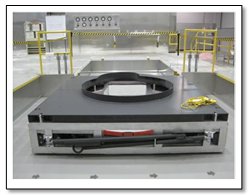
When I built the big cat tree, I just moved around the mess in my garage and I pulled my pickup out of the driveway to lay out the bigger pieces. The picture below is the J-2X assembly area. Note that there aren’t any flower pots with last year’s dead petunias, or half-empty bags of bird seed, or cast-off, half-used rolls of duct tape scattered about the floor. In other words, it doesn’t look like my garage. It is extremely clean and orderly. It is a FOD-free zone: FOD = foreign object debris. When assembling an engine, you do not want ANYTHING in the engine that does not belong there. I will be showing you pictures below of various stages of engine assembly so far and you will notice that there is tape and/or plastic closures over every open hole where something might accidentally fall. One dropped nut or hunk of wire or wad of tape and you’re either forced into a costly disassembly exercise to get the stuff out or, worst case should the FOD be missed and left in the engine, you could have an engine failure in test and the loss of tens of millions of dollars of hardware.
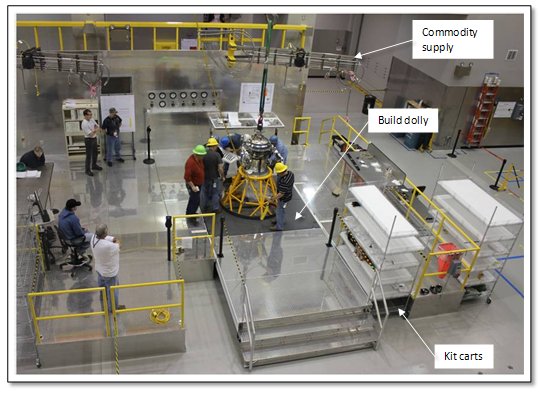
The other thing that you will notice from the picture of the assembly area is how well the whole thing fits together. Pieces of the floor retract to allow for the dolly to be positioned in the middle. The kit carts have bays into which they can slide for convenient access to the necessary hardware. There is an overhead boom with commodities available for when the assembly and checkout processes require gasses or electrical power or a hookup to a simulated vehicle stage computer. And, of course, just above the boundary of the picture is an overhead crane for lifting operations.
Now, can you just imagine the magnitude and glory of my cat tree if my garage was so neat, well organized, and fully equipped? Difficult to fathom, huh?
So, where does the engine assembly stand? Since I last reported the initiation of assembly, great strides have been made. Let’s step through the biggest pieces of the sequence. First, the birdcage was put into place on the build dolly. Remember, the yellow birdcage is a simulator for the first portion of the nozzle. Later, it will be replaced with the real nozzle. The dolly was then wheeled into place in the assembly area.
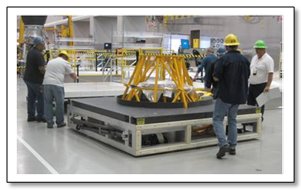
Below is the next sequence. The picture farthest on the left is the MCE, i.e., the main combustion element (composed of the main injector attached to the main combustion chamber) sitting in its shipping box. In the middle is a picture of the MCE with the turbopump arms installed. From these four heavy arms will be hung the fuel turbopump and the oxidizer turbopump. And, on the right, is a picture of this the whole assembly of MCE with the turbopump arms mounted on top of the birdcage.
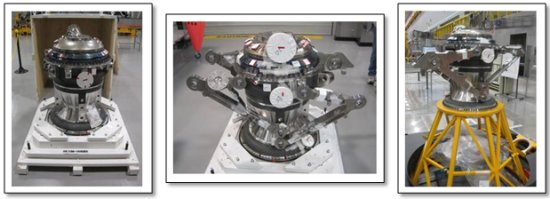
Next, the two turbopumps were installed, first the oxidizer turbopump and then the fuel turbopump. I can state that here quite simply in a single sentence, but go back to that series of pictures above: planning, lifting, moving, positioning, etc. A great deal of careful work went into each step.
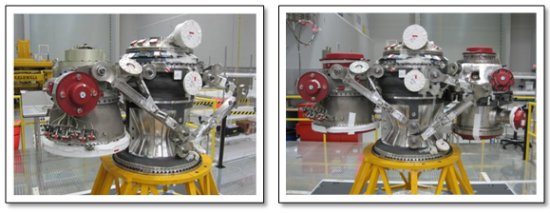
Now, I don’t know about you, but this is getting darn exciting for me. If I squint hard at that last picture and add some ducts in my mind, then that really looks a whole lot like an honest to goodness rocket engine. J-2X is coming together! In another month or so, it will be fully assembled and early this summer we will be demonstrating the first new, human-rated NASA rocket engine since 1975 (…yes, 1975, think: the fall of Saigon, Patty Hearst still on the lam, the Thrilla in Manilla – Ali v. Frazier III, Tiger Woods and Kate Winslet born, sentences being handed down for Watergate, the very first episode of Saturday Night Live, and me as the star kickball player during fifth grade recess…).
Two final notes for this article. First, I would like to thank Brian West for all of the engine assembly pictures and background information for these pictures. Keep up the great work! Second, I would like to thank my cat Kesey for his starring role in the center of the cat tree picture. Being that round and that lazy takes years of dedicated practice.

Hey, for news events of 1975, don’t forget the first appearance of Wolverine in an X-Men comic!
A cat of a NASA worker!!!! hahahaha. thanks for this incredible post. im going to use it to teach my argentines students of 6 grade !!!!
Great text and photos so far. I LOVE the technical aspects of rocket flight, especially new hardware like engines.
But any way to make your photos larger? Perhaps when someone clicks on them? I’m on a 21″ monitor and even with that large of a screen I can barely see the photos, so small that they appear in the blog.
Those pictures should really be clickable-for-a-bigger-version.
This is an excelent, well written, and informative article. Thank you for taking the time to describe a very precise and technical activity in terms that all can understand. I am looking forward to watching the build-up of this engine in the days to come
It is a great invention and victory.
It will be very useful for further tours.
It’s really great to see the progress on the first engine. Keep posting pictures!
Hiya, I’m really glad I’ve found this info. Today bloggers publish just about gossips and internet and this is actually annoying. A good web site with interesting content, that’s} what I need. Thanks for keeping this website, I’ll be visiting it. Do you do newsletters? Can’t find it. . Great blog right here! Also your website quite a bit up fast! What web host are you the use of? Can I am getting your associate link for your host? I wish my website loaded up as quickly as yours lol. .
Very good post, I was really searching for this topic, as I wanted this topic to understand completely and it is also very rare in internet, that is why it was very difficult to understand.
Thank you for sharing this.
Thank you so much for this! I haven’t been this moved by a blog for a long time!I am waiting for your next post too.
regards:
I read your post . it was amazing.Your thought process is wonderful.The way you tell about things is awesome.
They are inspiring and helpful.Thanks for sharing your information and views.
This is the perfect blog for anyone who wants to know about this topic. You know so much its almost hard to argue with you (not that I really would want…HaHa).
very informative post.